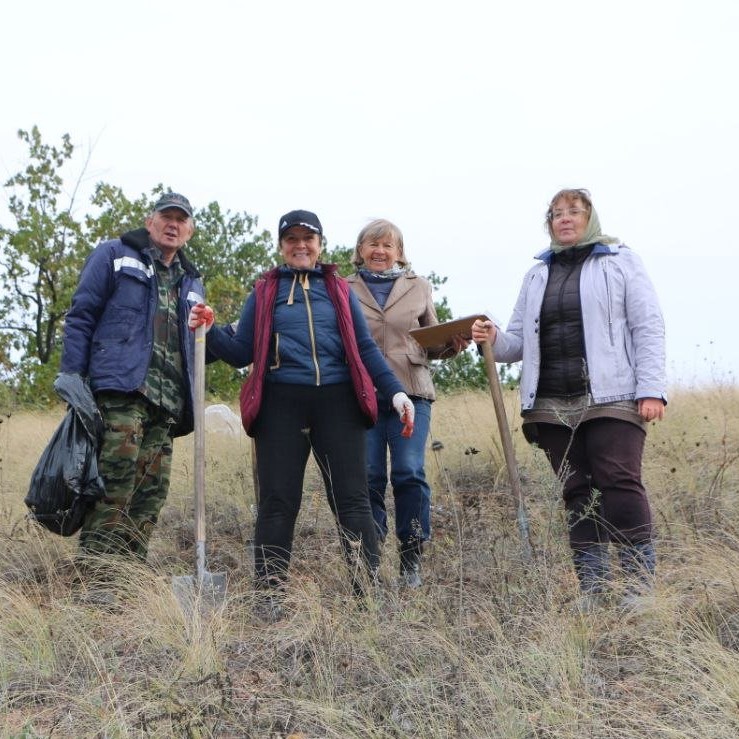The Botanical Garden of Samara University implemented the most massive relocation of rare plant species into the wild in its history and the first over last nine years. On one of the October days, more than 600 plants grown in the Botanical Garden were simultaneously planted on plots in the Chubovskaya Steppe in the Kinelsky District of the Samara Region. The work was carried out within the framework of the state contract on the instructions of the Regional Ministry of Forestry, Environmental Protection and Nature Management. Among the mass “migrants”, there is a fern leaf peony (Paeonia tenuifolia), which, according to scientists, might be a prototype of the famous little scarlet flower from Sergey Aksakov’s fairy tale.
In scientific terms, such relocation is called “reintroduction”: plants of a particular species (or specially prepared seed material) are taken out of comfortable conditions of beds and flowerbeds in the Botanical Garden into the wild, and planted in the territory where this species once grew earlier, but disappeared for some reason. This is how scientists try to recover and preserve biological diversity of the flora in the region, and create new sustainable populations of endangered or already extinct plants. For the last time the Botanical Garden carried out reintroduction in 2013, after which only monitoring of the plants was implemented.
“In our history, the current planting is the most massive non-recurrent one, it took us a single day to plant more than 600 species of rare plants from the Botanical Garden in the Chubovskaya Steppe at once. For example, if we compare, for several seasons from 2011 to 2013, our specialists planted into the wild about 1,300 plants. Of course, there are no special strict norms for reintroducing plants, we always take into account the existing opportunities (the volume of planting material available), and the need for creating population plant groups, with the hope for their survival”, said Professor Lyudmila Kavelenova, the Head of the Department of Ecology, Botany and Nature Preservation of Samara University.
For reintroducing and creating their population groups, plants of five species were selected: fern leaf peony, savin juniper (Juniperus sabina), Clematis integrifolia and two irises – leafless iris (Iris aphylla) and Iris halophila. Plants purposed for reintroducing were grown in the Botanical Garden on special seed rows in the form of rooted cuttings and seedlings (parts of bushes) with buds. A day or two before reintroduction, they are dug out and placed in bags made of thick film, in anticipation of moving in the wild. The main condition at this stage is that the weather does not fail.
“Usually, space of one Gazik belonging to the Botanical Garden was enough for both plants and us, but this year, for the first time, we had to use the university minibus. We chose the plots for planting in the Kinelsky District because of their low attendance by people – for better preservation of plants, as well as taking into account that natural ecosystems of these plots are typical for these plants. It is natural, since, according to their biological features, some species need to be planted on the edge of the forest, another – on the steppe slope, and some species require soil rich in calcium. We had to wait for the onset of favorable weather, which would allow us to work in the field. The rains that passed in the following days abundantly watered the reintroduced plants, which will help them successfully take root in the new place. In spring, one will be able to see the first results of our work”, said Svetlana Rozno, Director of the Botanical Garden.
According to her, the results of a number of previous reintroductions conducted in 2011–2013 show high-survival rate of relocated plants – on average, 85 %. The work of Samara scientists was highly appreciated by the International Council of Botanical Gardens for Plant Protection (BGCI). More than a dozen rare plant species have been returned to the regional wild, besides, the scientists managed to achieve stability and even growth of the population of fern leaf peony to be considered the prototype of the little scarlet flower.
In the Botanical Garden, fern leaf peony first appeared in 1947, it was brought just from the Kinelsky District. Already in the 60s of the last century, scientists wrote that it is rare in our area, and in the 70s, according to experts, this plant was obvious to have completely disappeared in our region. In the first edition of the “Red Book of the Samara Region”, published in 2007, this species was listed as an extinct one. Fern leaf peony was the first to be reintroduced from the Botanical Garden into the wild.
“Fern leaf peony is the very first to be reintroduced by us and at the same time the most successful, but we continue to work with it. It has not ceased to be rare yet: in nature it grows in our area only where we planted it. However, its population is stable and even gradually increase”, said Irina Ruzaeva, the Head of the Flora Department of the Botanical Garden. “This is the most early-flowering of peonies, there are simply no other plant species with such large scarlet petals in our nature; it blooms in the steppe in the first half of May, when many other herbaceous plants have not fully developed and turned green. Therefore, to my mind, Sergey Aksakov could well have seen it blooming in the steppes, and remembered it as the prototype of the fabulous little scarlet flower that he was told about in his childhood”.
For reference
Sergey Timofeevich Aksakov spent his childhood in the family estate, in the village of Znamenskoye (Novo-Aksakovo, Aksakovo) of the Orenburg Province, 200 km from Samara. The future author of the “Little Scarlet Flower” has visited various districts of the current Samara Region more than once. In the second half of the 19th century, the village of Znamenskoye was part of the Samara Province.
